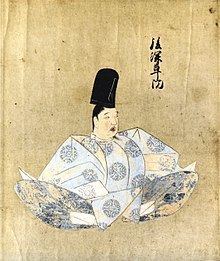Name Emperor Go-Fukakusa Died August 17, 1304 Parents Emperor Go-Saga | Role Sovereign | |
 | ||
Born June 28, 1243 ( 1243-06-28 ) Children Emperor Fushimi, Prince Hisaaki Grandchildren Emperor Hanazono, Prince Morikuni, Emperor Go-Fushimi Similar People Emperor Kameyama, Emperor Jimmu, Kakuei Tanaka, Hirohito, Akihito | ||
Emperor Go-Fukakusa (後深草天皇, Go-Fukakusa-tenno) (June 28, 1243 – August 17, 1304) was the 89th emperor of Japan, according to the traditional order of succession. This reign spanned the years 1246 through 1260.
Contents
This 13th-century sovereign was named after the 9th-century Emperor Nimmyo and go- (後), translates literally as "later;" and thus, he could be called the "Later Emperor Fukakusa". The Japanese word go has also been translated to mean the "second one;" and in some older sources, this emperor may be identified as "Fukakusa, the second," or as "Fukakusa II."
Name
Before his ascension to the Chrysanthemum Throne, his personal name (his imina) was Hisahito (久仁).
Although the Roman-alphabet spelling of the name of this 13th-century emperor is the same as that of the personal name of a current member of the Imperial family, the kanji are different:
He was the second son of Emperor Go-Saga.
Issue
Events of Go-Fukakusa's life
Hisahito-shinno (久仁親王) formally became Go-Fukakusa-tenno (後深草天皇) at the age of 2; and Go-Saga began to exercise power as cloistered Emperor.
In 1259, at the insistence of Retired Emperor Go-Saga, he abdicated at the age of 15 to his younger brother, who would become Emperor Kameyama.
After Emperor Go-Uda's ascension in 1260, Saionji Sanekane negotiated with the Bakufu, and succeeded in getting Emperor Go-Fukakusa's son Hirohito named as Crown Prince. In 1287, with his ascension as Emperor Fushimi, Go-Fukakusa's cloistered rule began.
In 1290, he entered the priesthood, retiring from the position of cloistered Emperor. But, with his seventh son, Imperial Prince Hisaaki becoming the 8th Kamakura shogun among other things, the position of his Jimyoin-to became strengthened.
In 1304, he died. He is enshrined with other emperors at the imperial tomb called Fukakusa no kita no misasagi (深草北陵) in Fushimi-ku, Kyoto.
Kugyo
Kugyo (公卿) is a collective term for the very few most powerful men attached to the court of the Emperor of Japan in pre-Meiji eras. Even during those years in which the court's actual influence outside the palace walls was minimal, the hierarchic organization persisted.
In general, this elite group included only three to four men at a time. These were hereditary courtiers whose experience and background would have brought them to the pinnacle of a life's career. During Go-Fukakusa's reign, this apex of the Daijo-kan included:
Eras of Go-Fukakusa's reign
The years of Go-Fukakusa's reign are more specifically identified by more than one era name or nengo.
